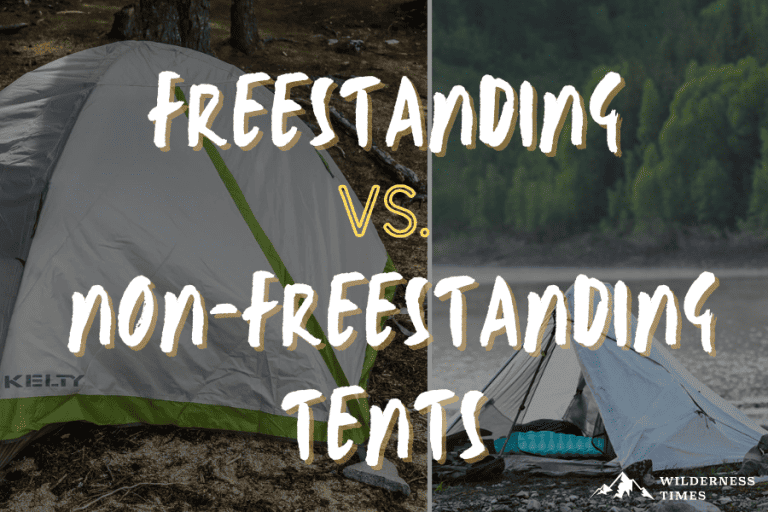You’ve probably heard of the comparison between freestanding vs. non-freestanding tents.
The differences between the two can be confusing. But don’t worry! That’s why we’re here to help you understand more about each tent design.
Here’s the quick version:
Freestanding tents use a network of internal poles to maintain their shape.
Non-freestanding tents use a single vertical pole and rely on stakes to help them maintain their structure.
While this may seem simple, there are several differences between the two tent types.
This article will cover a few of those differences and when to use each type of tent.
Table of Contents
ToggleFreestanding Tents
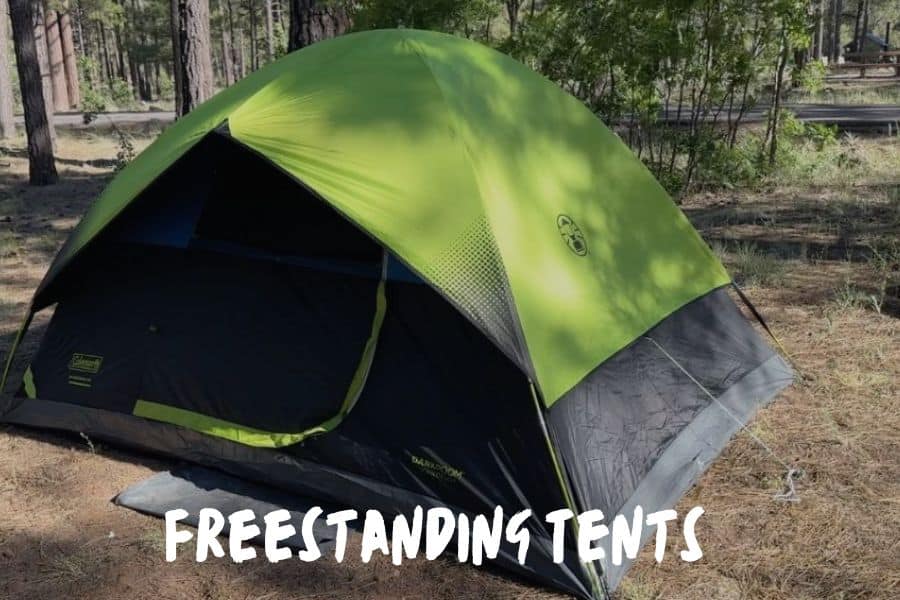
Freestanding tents contain an internal, double-wall structure supported by tent poles.
These tents get their name from staying erect from their internal structure. They don’t rely on external support, like stakes.
This type of tent makes up the majority of the “traditional” tents you’ll see in an outdoor store or on the trail.
Pros Of Freestanding Tents
- Easy to set up
- Portable
- Double-wall design
- Roomy interior
- Well-insulated
This type of tent is great for beginners because it’s relatively easy to set up and, once it’s set up, is likely to stay that way.
And, once you’ve constructed a freestanding tent, you can even move it around the camp to another spot if needed.
Freestanding tents also tend to have more interior space, giving campers room to maneuver and store their gear.
Also, most freestanding tents are double-walled. This is super effective at keeping heat inside the tent while also keeping condensation out.
The reliable structure, roomy interior space, and double-wall design make freestanding tents the type of tent you want to wait out a storm in.
While these tents can be used throughout the seasons, they really shine in more extreme weather conditions.
Cons Of Freestanding Tents
- Heavier
- Riskier in high winds
- Reliant on poles and stakes to stand upright
The main drawback for the freestanding tent model is the weight. They require a tent structure, a rain fly, poles, and stakes. So, they can be heavier than non-freestanding tents.
In general, a standard 2-person, freestanding tent can weigh in anywhere from 3–4 lbs.
While this might not sound like much, this amount of weight can add up in your pack during a long trek.
When using a freestanding tent on a backpacking trip, try to split up the tent materials among the group. Make sure that one person isn’t stuck with the entire weight of the tent.
It’s also worth mentioning that there is a wind risk with freestanding tents if you don’t stake them down.
Because they maintain their structure on their own, freestanding tents can catch wind and be blown away.
While it might be tempting not to, always stake down your tent to keep it in one place.
Finally, the poles used for freestanding tents are usually tent-specific. Campers can find themselves in a pinch if a pole breaks on the trail.
If the pole can’t be patched up with duct tape, the camper will need to reach out to the specific manufacturer for a replacement.
Non-Freestanding Tents

Non-freestanding tents are an ultralight tent alternative that does not have pole-system structure.
They are instead erected by a single support pole and a series of stakes.
The most common support pole used by campers is a hiking pole since many already bring a pair with them on long treks.
However, in a pinch, campers can use a stick or other similar objects, making these extremely adaptable tents.
Pros Of Non-Freestanding Tents
- Ultralight
- Quick to set-up
- Waterproof & Water-resistant
The biggest advantage to non-freestanding tents is their weight (or lack thereof).
Because they only involve a single-walled tent, a single pole, and a series of stakes, they are much lighter than freestanding tents.
In general, a 2-person non-freestanding tent will average around 1 pound in weight.
Additionally, once you get familiar with the process, setting up a non-freestanding tent is quick and easy.
All you’ll need to do is pick a good piece of ground, insert the support pole, and stake down the edges of the tent.
Another important distinction for non-freestanding tents is that they are single-walled and don’t use a rain fly. To account for this, all of the fabric used is treated to be waterproof.
If you’re caught in the rain while you’re setting up camp, non-freestanding tents will keep the tent interior dry during the downpour.
Cons Of Non-Freestanding Tents
- Single-wall design
- Unreliable in bad-weather
- Easily collapsible
- Poor insulation & ventilation
In general, non-freestanding tents are not as reliable in unfavorable weather conditions.
Because the set-up process for non-freestanding tents relies on a single hiking pole and a set of stakes, the margin of error is small.
This means that if the support pole or any stake is affected by the weather, you risk your entire tent structure collapsing.
Also, the single-wall design is not as effective at trapping heat inside the tent. You might feel colder in a non-freestanding tent than you would in a freestanding one.
Plus, they aren’t as effective at ventilation or preventing condensation from building. Unfortunately, that built-up moisture can drip onto you and your gear while you’re sleeping.
Freestanding Vs. Non-Freestanding: Compared
| Performance Factor | Freestanding Tents | Non-Freestanding Tents |
| Set-Up & Breakdown | x | |
| Stability & Wind Resistance | x | |
| Flexibility In Campsite Selection | x | |
| Weight & Packability | x | |
| Durability & Longevity | x | x |
Set-Up & Breakdown
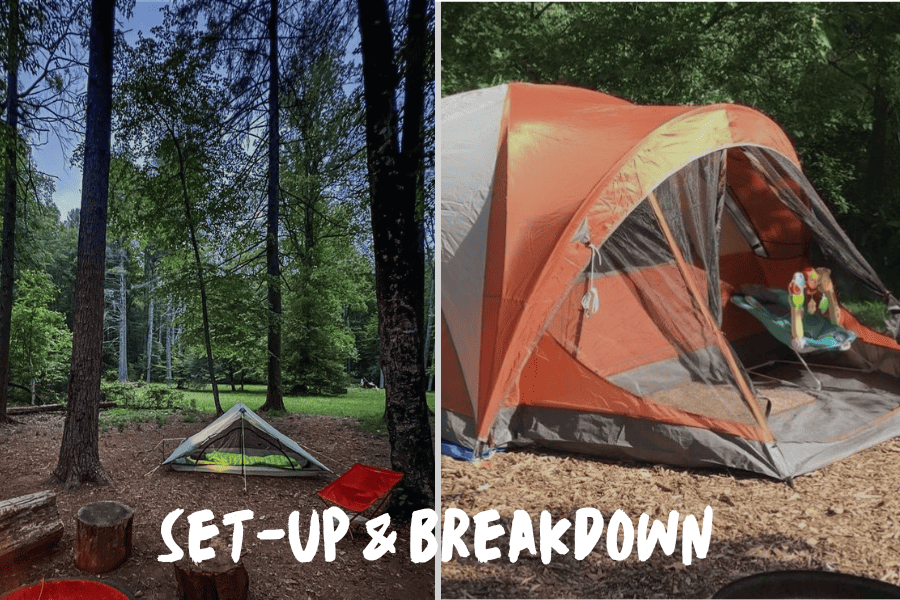
At the end of the day which type of tent is easier to set up will depend on your own skill set and how familiar you are with each type of tent.
Once you’ve been on the trail with any particular tent, you become a pro in setting up and breaking camp.
From an efficiency perspective, non-freestanding tents are going to win out during set-up and breakdown.
These tents only require you to insert a hiking pole into the center of the tent, and then stake down the outside edges of the tent.
You can also set up non-freestanding tents in the rain without getting the inside of the tent wet.
In comparison, freestanding tents need many poles inserted into the structure of the tent to set it up.
After the tent has been set up, you need to stake the structure down in several spots.
Because freestanding tents are double-walled, you have to set up the structure before you can put the rain fly up. This could potentially get anything inside the tent wet during inclement weather.
It’s also easier to clean freestanding tents because their structure is more intact. You can pick up the tent and shake any debris out through the unzipped door.
In comparison, a non-freestanding tent is going to be a bit more challenging to clean.
Winner: Non-Freestanding
Stability & Wind Resistance
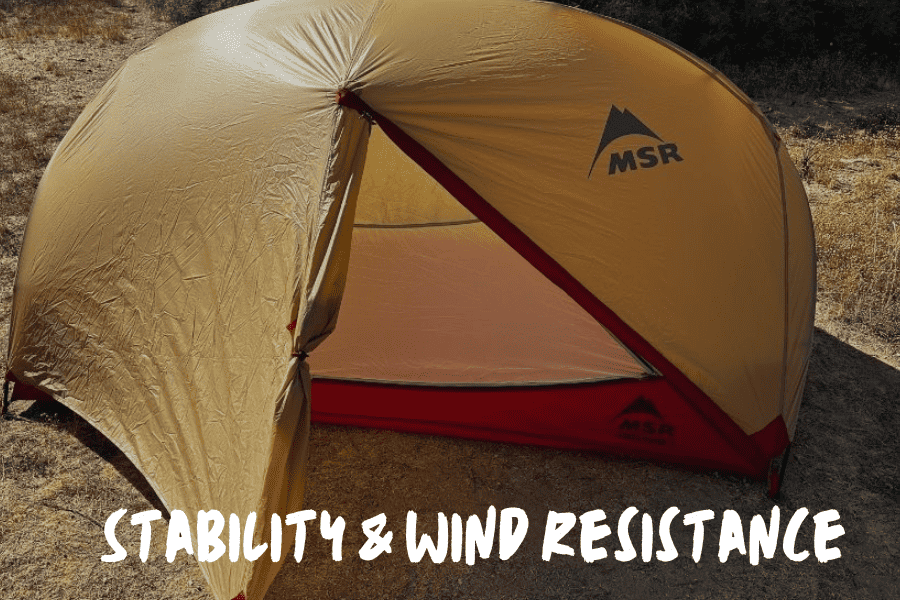
When strong winds or bad weather is in the forecast, it’s always better to have a freestanding tent.
These tents are not only roomier, but they are also better at weather-protection.
In unfavorable weather conditions, non-freestanding tents depend on the single point of structure. They are one strong gust away from collapsing.
A stake coming out of the ground can compromise the fragile structure, which can happen in strong winds.
Winner: Freestanding
Weight & Packability
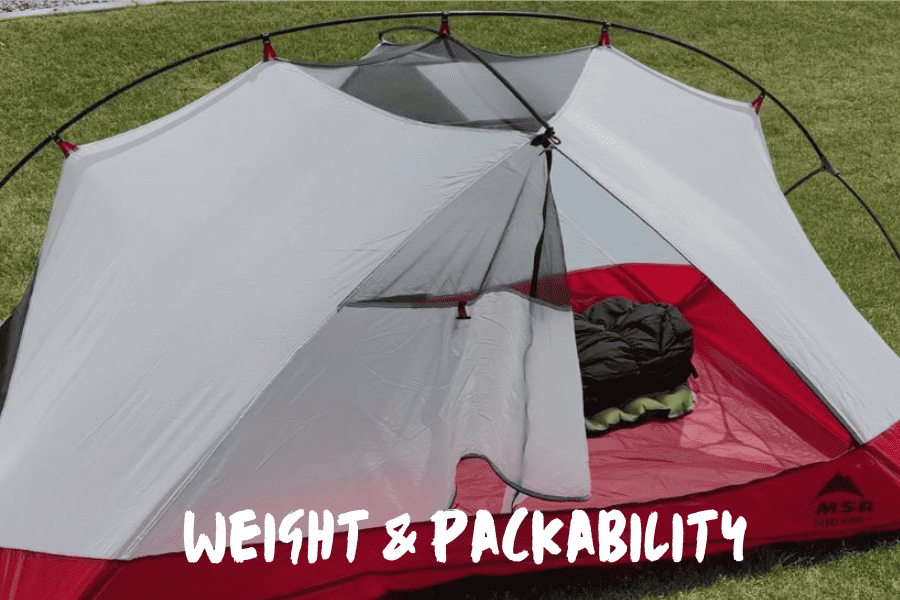
This is an area where non-freestanding tents are a clear winner.
They do not have extra fabric layers or need extra poles or stakes. Non-freestanding tents are generally lighter and more compact than freestanding tents.
On average, the weight of a 2-person non-freestanding tent is usually around 1–2 pounds.
Freestanding tents average anywhere between 3–4 pounds for a 2-person design.
So, they are going to be heavier since they need extra poles and stakes, which can add weight and bulk to your pack.
Winner: Non-Freestanding
Flexibility In Campsite Selection

If you’re looking for dependable flexibility and versatility, freestanding tents will be your best bet.
Freestanding tents can be set up almost anywhere because they don’t rely on stakes as heavily as non-freestanding tents.
Non-freestanding tents rely on staking to maintain their overall structure.
You can stake freestanding tents down using alternative methods without compromising the structure.
This can be a difficult task to do for non-freestanding tents, especially on rocky or uneven ground.
In either case, camping on rocky or uneven ground will require alternative staking methods. The “big rock, little rock” technique is usually best for this.
This technique involves tying the end of the guyline around a smaller rock. Then after pulling the guyline taut, you place a larger rock on the “tent” side of the smaller rock to lock it in place.
Winner: Freestanding
Durability & Longevity
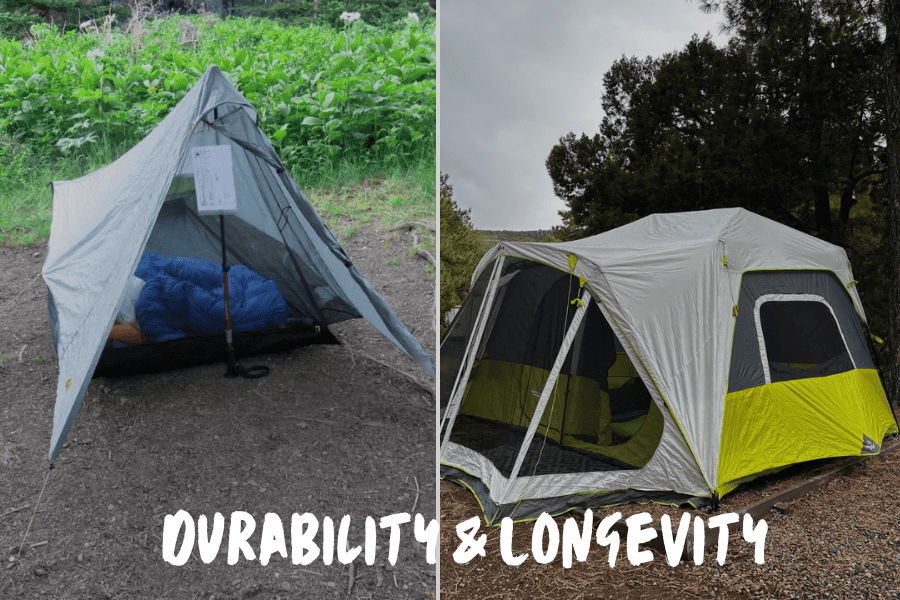
Both options are strong contenders when it comes to durability.
For the most part, freestanding and non-freestanding tents are similar in materials.
What matters is how lightweight those materials are. Manufacturers will sacrifice material durability to make those materials “ultralight”.
The more lightweight the material, the more likely it will be vulnerable to ripping on the trail.
This trade-off can be worth it for the right camper, but it is always worth considering.
Winner: Tie
Factors To Consider When Choosing Freestanding VS Non-Freestanding
Camping Environment & Conditions
Freestanding tents are the more versatile option.
Their double-wall structure really shines in bad weather and can help keep you warmer and dryer during cold and wet conditions.
Non-freestanding tents are by no means useless during these conditions. They will likely keep you protected from the elements, just not as effectively as a freestanding tent.
However, both types of tents will work well in moderate conditions. If you’re headed out on a trek in moderate conditions and are especially worried about pack weight, a non freestanding tent will serve you well.
Trip Duration
If you’re headed out for a long trek and pack weight is a primary concern, a non-freestanding tent would be a great tent option.
Because this type of tent can compress down in size and doesn’t require poles, it’s likely that you’ll save space and weight in your pack.
Non-freestanding tents can be an especially great option if you’re hiking alone. If you have to carry the entirety of your shelter on your own back, you want it to be lighter.
However, if you’re headed out in more extreme weather conditions or with other people, a freestanding tent is the best option for you.
This tent design’s double layer will keep you extra insulated.
Bonus points if you can split up the extra weight of the freestanding tent among multiple packs!
Experience Level
To put it simply, more trip-ending mistakes can be made with non-freestanding tents than freestanding tents.
That being said, if you’re a beginner in the outdoors world, I recommend you start with a freestanding tent.
This type of tent is more straightforward to set up and will keep you warm and protected from the elements.
They are also good for a variety of environments and weather conditions, meaning they’re slightly more versatile.
If you’re in the market for your first tent purchase, freestanding is a great design to start with.
Non-freestanding tents are more advanced and are best for individuals who are more experienced in the outdoors world.
Budget Considerations
There is no large cost difference between the two based on their freestanding vs. non-freestanding designs alone.
Yet, you will likely find a difference if the tent is classified as lightweight or not.
A lightweight freestanding tent will be similar in price to a lightweight non-freestanding tent. But they will likely have different actual weights.
Following this same logic, an “average” freestanding tent will cost roughly the same as an “average” non-freestanding tent.
Basically, the more high-tech materials a tent has and more lightweight a tent is, the higher the price tag.
FAQs
What Are The Main Benefits Of A Freestanding Tent?
Freestanding tents are an incredibly reliable and versatile type of tent, especially in bad weather. If you’re stuck in a storm that lasts a few days, you want a freestanding tent.
Generally speaking, freestanding tents have more interior space when compared to non-freestanding tents.
Additionally, their double-wall design keeps out condensation, so it won’t drip on you in the middle of the night!
How Do I Anchor A Non-Freestanding Tent In Rocky Terrain?
If you find yourself setting in rocky conditions, setting up your non-freestanding tent can be tricky. You might need to use alternative methods.
If you can’t find any good ground for staking, you can always tie the end of your guy lines around rocks, using the “big rock, little rock” method.
Is One Type Of Tent More Suited For Solo Camping Than The Other?
Purely based on weight, non-freestanding tents are a great option for a solo camper who has to carry their pack alone.
However, solo camping with a freestanding tent is completely doable – as long as you’re fine with a little extra weight.
How Do Tent Materials Factor Into The Freestanding Vs. Non-Freestanding Debate?
Most tents use a combination of water-resistant treated polyester and nylon materials.
Non-freestanding tents’ single-wall design uses less materials and fabric overall.
This single wall of fabric has to insulate the inside of the tent while also protecting them from the outside. So, it is usually treated to be waterproof.
In comparison, freestanding tents use more fabric and materials overall to make up both layers of their double-wall design.
While all layers of fabric are generally water resistant, this type of design relies heavily on a waterproof rain fly layer to keep everyone dry.
Can I Convert A Freestanding Tent Into A Non-Freestanding One?
No. Because the two types of tents have different designs, you cannot convert a freestanding tent into a non-freestanding tent.
Is There An In-Between Option For The Two Types Of Tents?
Yes! If you’re looking to dabble in non-freestanding tent styles, but aren’t completely ready to take the leap, you can try a semi-freestanding tent option!
Semi-freestanding tents have an internal pole that runs from the top to bottom edges. This maintains a large part of the tent structure, and stakes do the rest.
Because the pole is internal, these tents are more stable than non-freestanding tents. Though they are also lighter than your average freestanding tent.
Final Thoughts On Freestanding Vs. Non-Freestanding Tents
When you need to decide between a freestanding vs. non-freestanding tent, it is wholly up to you.
Your level of experience, the camping conditions of your trip, and your personal preferences all factor into this decision.
Freestanding tents are going to be the best for beginners. They are also great for campers headed into extreme weather conditions.
But if you aren’t willing to carry a little extra weight, they may not be for you.
Non-freestanding tents are best for more experienced outdoors people.
They’re best for more moderate conditions or individuals who are especially worried about their pack weight.
With all of these factors in mind, you can choose the tent that’s best for you!


